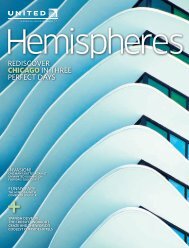april-2012
april-2012
april-2012
You also want an ePaper? Increase the reach of your titles
YUMPU automatically turns print PDFs into web optimized ePapers that Google loves.
HOW IT’S DONE<br />
Dream Machine<br />
Nearly every boilerplate air-travel article lists the following<br />
tips for making fl ying more pleasant: Bring earplugs<br />
or an eye mask to help you sleep, keep the moisturizer<br />
fl owing so your skin doesn’t dry out, and throw in a few<br />
carbon-emission off sets to salve your conscience. These<br />
steps only go so far, however, which is why Boeing’s new<br />
787 Dreamliner (making its debut with United later this<br />
year) is such big news among frequent fl yers, airplane<br />
afi cionados and engineers alike. It’s constructed from a<br />
carbon composite that permits larger windows, a quieter<br />
cabin and higher humidity, and increases fuel effi ciency<br />
to boot. Long in the making, it is, by all accounts, a technological<br />
marvel. Here’s how they did it. BY JACQUELINE DETWILER<br />
3<br />
1<br />
2<br />
1 The 787 is made primarily of<br />
carbon fi ber–reinforced plastic<br />
(CFRP), similar in theory to<br />
steel-reinforced concrete. CFRP<br />
is lighter and stronger than metal,<br />
which reduces the weight of the<br />
aircraft. Combined with the 787’s<br />
state-of-the-art engine (either<br />
a Rolls-Royce Trent or a General<br />
Electric GEnx), this equals a<br />
20 percent increase in fuel<br />
effi ciency. CFRP is also harder to<br />
corrode than metal, which allows<br />
for higher humidity in the cabin.<br />
2 On most modern airplanes,<br />
HEPA fi lters screen the air for<br />
pollen and pathogens but miss<br />
some organic compounds—from<br />
fabrics, paints, foods and passengers<br />
themseves—that can irritate<br />
your lungs and sinuses. The 787’s<br />
new gaseous fi ltration system<br />
absorbs these compounds,<br />
increasing the chances that you’ll<br />
feel better upon arrival.<br />
3 The typical airplane interior<br />
is pressurized to create an “altitude”<br />
of 8,000 feet—any lower,<br />
and the diff erence between the<br />
cabin and the outside air would<br />
put undue strain on the walls.<br />
Because CFRP is stronger than<br />
metal, the 787’s interior altitude<br />
can be lowered to 6,000 feet,<br />
reducing the likelihood of passenger<br />
fatigue and headaches.<br />
ILLUSTRATION BY ANDREW BAKER HEMISPHERESMAGAZINE.COM • APRIL <strong>2012</strong> 39
















